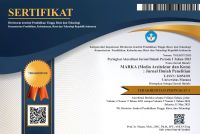Arsitektur Tradisional Rumah Adat Sapo Jojong Suku Pakpak di Kabupaten Pakpak Bharat
Abstract
Characteristics of the Sapo Jojong Traditional House in Penanggalan Binanga Boang Village, has the characteristics of a traditional Pakpak house which is considered quite representative as one of the traditional houses in Pakpak Bharat Regency. The aim of this research is to identify the historical development and architectural aspects of the Sapo Jojong traditional house. Some of the architectural aspects identified include: the spatial system (patterns of spatial relationships, orientation, and hierarchy), the physical system (physical form, space dividers, and materials), and the model system (roofs, columns, openings, ornaments/decoration). The method used in the research on the architectural characteristics of the Sapo Jojong traditional house is a survey method (direct observation) conducted in March-April 2023. Starting with the initial data collection followed by semi-structured interviews and conducting field observations, then the data is analyzed using qualitative descriptive methods.The results of this research show the architectural development of the Pakpak tribe and the characteristics of Sapo Jojong which can be seen from the identification of the spatial, physical, and model systems.
Downloads
References
Amalia, A. (2014). Karakteristik Arsitektur Rumah Adat Wajo Di Kompleks Budaya. Teknosains: Media Informasi Sains dan Teknologi, 8(2), 227-240.
Hamzah, E. R., Radhi, M., & Harimurti, P. (2022). Kajian Segmen Fasade Rumah Tinggal Tradisional Melayu Di Tepian Sungai Kapuas Kampung Tambelan Sampit Kota Pontianak. Vokasi: Jurnal Publikasi Ilmiah, 17(2), 82-90.
Iswanto, D. (2020). Pengaruh bukaan terhadap kenyamanan termal pada ruang kelas di kampus teknik arsitektur universitas diponegoro tembalang. IMAJI, 9(4), 421–430.
Khamdevi, M. (2019). The Architectural Characteristics Linkage of Batang Kuantan’s Rumah Godang With Tanah Datar’s Rumah Gadang. Langkau Betang: Jurnal Arsitektur, 6(2), 111-120. https://doi.org/10.26418/lantang.v6i2.34527
Purba, F. R. (2015). Penerapan Ornamen Pakpak Pada Gedung Perkantoran Pemkab Pakpak Bharat Ditinjau Dari Bahan Bentuk Teknik Dan Warna (Doctoral Dissertation, Unimed).
Soedewo, E. (2018). Jejak Keindiaan (Hindu-Buddha) dalam Kebudayaan Pakpak. Berkala Arkeologi Sangkhakala, 11(21), 41–52. https://doi.org/10.24832/bas.v11i21.229
Sitepu, N. B. (2021). Analisis Semiotik Simbol Bangunan Rumah Adat Suku Pakpak Kabupaten Dairi (Doctoral Dissertation).
Habraken, J. (1988). Type as a social agreement. In The Short Works of John Habraken, 336–345. https://doi.org/10.4324/9781003011385-50
Kurniawan (1990). Jejak Hindu Di Tanah Batak. Bogor: Kurnia.
Moneo, R. (1978). On Typology. Oppositions 13.
- Abstract 333
- PDF (BAHASA INDONESIA) 462
Copyright (c) 2023 Nurmalasari Tumangger, Armelia Dafrina, Fidyati Fidyati, Diana Khairani Sofyan

This work is licensed under a Creative Commons Attribution-ShareAlike 4.0 International License.




















